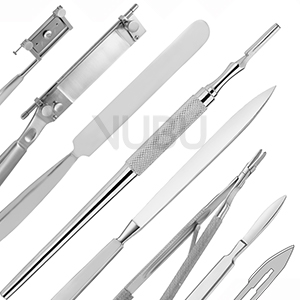A scalpel or surgical knife is an indispensable tool in surgery, used for cutting through skin, fatty tissue, and muscle tissue. At VUBU, we offer a wide range of surgical scalpels and knives, available with both fixed and interchangeable blades. The latter are among the most commonly used scalpels in surgery, as they allow for the reuse of the scalpel handle and provide the flexibility to insert different blades depending on the application.
Advantages of Scalpels with Interchangeable Blades
Flexibility: By using different blades, surgeons can adapt the scalpel to the specific requirements of the procedure.
Cost Efficiency: The handle can be reused, while only the blades need to be replaced.
Hygiene: Interchangeable blades allow for easy and safe disposal after each use, reducing the risk of infection.
Types of Surgical Knives and Their Applications
Surgical knives vary greatly in their applications. Key types include:
Amputation Knives: Used for the amputation of limbs, characterized by their robust construction and sharp blades.
Autopsy Knives: Used in autopsies to precisely cut and examine tissue.
Brain Knives: Specifically designed for neurosurgical procedures to make precise cuts in brain tissue.
Transplant Knives: Used for harvesting and placing transplants, designed for fine cuts.
Dermatomes: Used in skin grafting, particularly for treating severe burns. These instruments enable the precise harvesting of skin grafts.
Blade Breakers for Safe Disposal
To ensure safety in the operating room, we also offer blade breakers. These tools allow for the easy and safe removal and disposal of used scalpel blades. This reduces the risk of injuries from sharp blades and ensures a hygienic working environment.
Our Product Range
Our assortment includes:
Scalpels with Fixed Blades: For specialized applications where high stability is required.
Scalpels with Interchangeable Blades: For maximum flexibility and adaptability to various procedures.
Surgical Knives: For specialized applications such as amputations, autopsies, neurosurgery, and transplants.
Dermatomes: For skin grafting in cases of burns or other skin defects.
Blade Breakers: For the safe disposal of used blades.
Innovations in Scalpel Technology
Modern scalpels and surgical knives are characterized by innovative features, such as:
Ergonomic Handles: For comfortable handling and reduced hand fatigue.
High-Quality Materials: For maximum durability and safety.
Non-Slip Coatings: For secure handling even under challenging conditions.
Conclusion
Our scalpels and surgical knives are specifically designed to provide optimal support to surgeons in a wide range of procedures. With their precise cutting performance, robust construction, and innovative features, they are indispensable tools in modern surgery. Explore our extensive range and benefit from instruments that meet the highest quality standards and make your work easier.
A scalpel is an indispensable surgical instrument used for the precise cutting of tissues during medical procedures. It is one of the most commonly used tools in surgery, known for its sharp blade and precise handling. While surgical instruments were once reused after cleaning and sterilization, disposable instruments are now primarily used. However, with scalpels, often only the blade is replaced, while the handle is reused. This provides a cost-effective and hygienic solution for modern operating rooms.
Types of Scalpel Blades and Their Applications
There are various types of scalpel blades, each designed for specific applications. The choice of the right blade depends on the type of procedure, the tissue to be cut, and the surgeon's individual preferences. Below is an overview of the most common scalpel blades and their uses:
Blades for #3 or #7 Handles:
No. 10: Ideal for cutting through skin and muscles. The blade is curved along the cutting edge and the back, allowing for precise and clean incisions.
No. 10a: Similar to the No. 11 but with a less pointed tip. It is suitable for finer cuts in delicate tissue.
No. 11: A long, triangular blade with a sharp tip, sharpened along the longest side. It is often used for precise cuts and stab incisions.
No. 12a: A small, pointed, crescent-shaped blade sharpened on the inner edge. It is particularly suitable for fine cuts in tight or hard-to-reach areas.
No. 12b: A small, pointed, crescent-shaped blade sharpened on both sides. It offers greater flexibility in making incisions.
No. 15: A smaller version of the No. 10 blade, ideal for fine and precise cuts in smaller surgical fields.
No. 15c: A variant of the No. 15 with an angled, flatter, and thinner profile. It is particularly suitable for minimally invasive procedures.
Blades for #4 Handles:
No. 18: A symmetrically pointed blade with a curved shape. It has a sharper angle than the No. 23 blade and is suitable for deep cuts in resistant tissue.
No. 20, 21, 22: Larger versions of the No. 10 blade. The No. 22 is larger than the No. 21, which in turn is larger than the No. 20. These blades are suitable for larger incisions in skin and muscles.
No. 23: A symmetrically pointed blade with a curved shape. It has a blunter angle than the No. 18 blade and is often used for general surgical cuts.
No. 24: A wide, flat blade with an angled cutting edge. It is suitable for flat cuts in skin and soft tissues.
No. 25: A straight blade with a flat back facing the front. It is often used for precise cuts in delicate tissue.
Advantages of Scalpels with Interchangeable Blades
Flexibility: By using different blades, surgeons can adapt the scalpel to the specific requirements of the procedure.
Cost Efficiency: The handle can be reused, while only the blades need to be replaced.
Hygiene: Interchangeable blades allow for easy and safe disposal after each use, reducing the risk of infection.
Conclusion
Choosing the right scalpel blade is crucial for the success of a surgical procedure. Our extensive range of scalpel blades and handles offers surgeons the flexibility and precision they need for a wide variety of applications. Explore our products and benefit from high-quality instruments that meet the highest standards and make your work easier.
